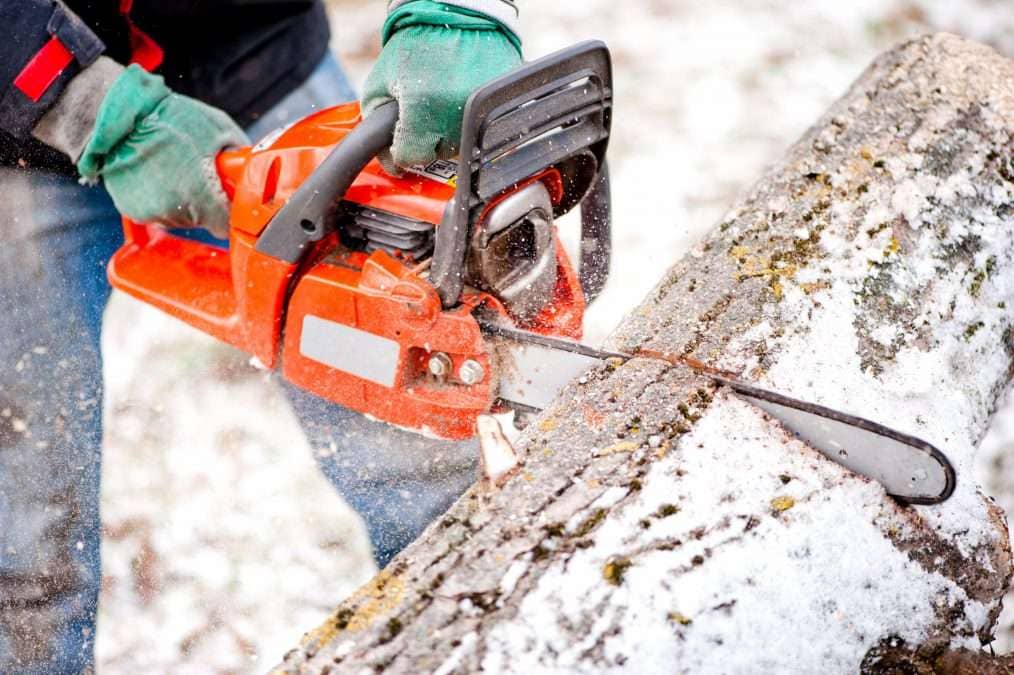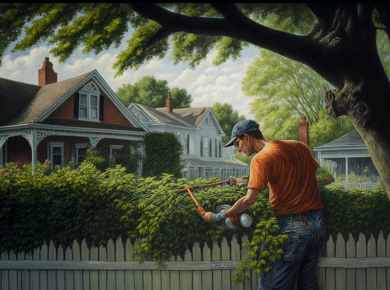Tackling Tree Drama with Neighbors
Disputes over trees with neighbors? Yup, they happen—a lot. Overhanging branches, fallen leaves, and debris can turn the best of neighbors into legal foes. Here’s your quick guide to sorting it all out without losing your cool (or your sanity).
Homeowner’s Tree Takedown Guide
Your yard, your rules—sort of. Anything that grows into your space from next door is fair game for a trim, just be ready to deal with the consequences.
- Trimming Overhanging Branches: Feel free to cut back branches that poke into your domain, but keep those snippers within your property line. No trespassing allowed!
- Handling Fallen Branches: Got branches falling into your yard? They’re your problem now—time to break out the rake.
- Debris Disposal: Any branches you cut or that crash-land on your property are yours to deal with. No tossing them back over the fence without asking first—seriously, don’t be that neighbor.
| Action | Your Job |
|---|---|
| Trimming branches hanging over | Go ahead, but stay on your side of the line |
| Dealing with fallen branches | Your yard, your mess |
| Getting rid of cut branches | Your responsibility to haul away |
Before you get snipping, check out your local laws ’cause they can throw some curveballs at you.
Utilities: Power Play with Trees
Utility companies are like that helpful-yet-annoying neighbor who thinks trimming your trees is their business. And, guess what? Legally, they’re right.
- Inspection and Trimming Rights: They can march right onto your property to clear anything that might mess with the power lines. It’s in the property deed—didn’t read the fine print? Too late now!
- Clearance Guidelines: Utilities aren’t just hacking away for the fun of it. They usually clear a path around power lines, keeping things 3-5 years safe from overgrowth. Lower voltage lines hanging to your house? Those branches gotta go, too.
You’ll probably have to deal with the clean-up after the utility team leaves. No free rides here. Got an issue? Dial up the electric company and let them know.
Let’s Keep it Comfy Under the Shade
Staying in the loop about who’s responsible for what with your trees can keep neighborly love from turning into a feud. Brush up with some more useful reads here: Who handles overhanging tree branches and Fallen trees and cleanup duties.
Tree disputes might just be nature’s way of keeping us on our toes. Stay sharp, stay informed, and keep those yard boundaries clear—literally.
Let’s Talk Tree Trimming Rules
Got a tree problem with the neighbors or utility lines? Here’s the lowdown on what you need to know about trimming trees, handling utility company rules, and keeping up with local laws.
Utility Company Rules
It’s not just about keeping the lights on. Utility companies have the right (called easements) to come onto private property to check or trim trees. This right stays with the property—when you buy the house, you buy into these rules.
Usually, they trim branches to keep a safe distance from power lines for about 3-5 years. For service lines, they just deal with branches touching the insulated, lower voltage wires. Heads up: when the utility folks trim the trees, you’ve got to deal with the mess. Got questions or problems? Ring up your electric utility provider.
| Task | Who Handles It |
| – | – |
| Keeping power lines clear | Utility companies do this to avoid outages. |
| Cleaning up after trimming | That’s on you, the homeowner. |
| Doing your own trimming | Go for it, just be careful of those power lines! |
Your Tree, Your Duty
So you’ve got a tree in the yard—what next? You can trim it yourself, but play it safe to avoid getting hurt or causing trouble with the power lines. If it’s a big job, maybe call in the pros. Sometimes, utility companies might even agree to take a tree down completely if it’s a repeated problem (Ohio Consumers’ Counsel).
Local Laws on Tree Removal
Each city has its own set of rules about taking trees down. In places like Atlanta, Chicago, and Portland, you might need a permit depending on the tree’s size and type. Atlanta, for example, says you need a permit to cut down hardwood trees that are 6 inches in diameter or bigger. Portland requires permits for heritage trees—those special or rare ones (Tree Removal).
| City | Permit Needs |
| – | – |
| Atlanta | Permit if the hardwood tree is 6 inches or larger in diameter |
| Portland | Need permits for heritage trees |
| Chicago | Permit rules depend on the tree’s type and health |
Make sure to check out your local tree rules to avoid fines or legal headaches. Want more info on handling tree issues with neighbors? Check out articles on cutting overhanging branches and removing fallen trees.
Tree Laws You Didn’t Know About
Got a tree tussle with your neighbor? Knowing your local tree laws can save you from turning it into an epic saga. Cities have their own quirky rules about tree removal and care, and messing up might land you in hot water.
Nashville’s Tree Rules
In Nashville, Tennessee, it’s not just about the Grand Ole Opry; the trees get some love too. For trees six inches or wider on certain properties, you gotta get a permit to chop them down. This rule is all about keeping the greenery and the good vibes. Cut down a “protected” tree? You’re on the hook to plant a new one (Tree Removal).
The Skinny on Permits
Tree removal permits are like poker hands: different cities, different rules. Here’s a cheat sheet for some big cities:
| City | When You Need a Permit |
|---|---|
| Nashville | Trees 6 inches or more wide |
| Atlanta | Hardwood trees wider than 6 inches |
| Chicago | Depends on tree species and size |
| Portland | Heritage trees (think trees with stories to tell) |
| New York City | Trees 6.5 feet around (yep, they measured) |
| Albany | Trees about to cause a public ruckus |
| Dallas | Usually no permit unless it’s hazardous |
| Sioux Falls | Pretty chill, usually no permits |
| Miami | No permits, but don’t get wild |
Big City Tree Rules
Cities have their own ways to keep the urban jungle in check. Look at these:
-
New York City: If your tree’s waistline is six and a half feet, you need a permit to say goodbye. They’re big on keeping their leafy populace intact.
-
Atlanta: For hardwood trees thicker than six inches, you need a permit. They’re serious about their senior tree citizens.
-
Chicago: Windy City folks need permits based on tree species and size. It’s all about keeping their urban forest in line.
-
Portland: Heritage trees (with history or cultural vibes) get extra protection here, needing permits for any big changes.
Getting hip to your local tree laws can save you trouble. If you’re tangled up with your neighbor about overhanging branches or a fallen tree, check out our guides on who cleans up the overhanging branches and handling fallen tree dilemmas. Be the tree law hero your neighborhood needs!
How Trees Chat: The Secret World of Tree Talk
Trees have some seriously cool ways to chat with each other, shaking off that old idea of trees being lone rangers. Getting how trees “talk” might even help you with that pesky neighbor dispute over tree branches.
Underground Mushroom Magic
Trees are like pen pals, but instead of writing letters, they use underground fungal networks. These hidden highways let them swap water, nutrients, and even send out SOS signals when they’re thirsty or sick. Fungus and trees are buddies in this game, helping each other out like a supportive community (Smithsonian Magazine).
| Aspect | Details |
|---|---|
| Network Type | Underground fungal networks |
| Functions | Share water, nutrients, and distress signals |
| Relationship | Symbiotic with fungi |
The Big Mama Trees
Imagine the oldest, wisest trees in the forest as “mother trees.” They’ve got connections like you wouldn’t believe, helping the young ones grow by sharing nutrients and water. And they don’t just hand out goodies – they also sound the alarm when trouble’s coming. Cut down these big mamma trees, and the survival of their sapling neighbors dives (Smithsonian Magazine).
| Feature | Importance |
|---|---|
| Type | Mother trees |
| Need | Nurture younger trees |
| Risk | Removal impacts survival |
Trees’ Talk in the Breeze
But trees aren’t just chatting underground; they use the airways too. Trees like acacias shoot out distress scents when nibbled by giraffes, alerting nearby trees to armor up their leaves with bitter tannins. It’s like a forest-wide emergency broadcast system (Smithsonian Magazine).
| Communication Type | Details |
|---|---|
| Mode | Airborne pheromones and scents |
| Example | Acacia trees produce distress gases |
| Function | Alerts neighboring trees for defense |
Understanding how trees look out for each other not only tickles the brain but might also offer some peace and practical solutions when you’re squabbling over whose job it is to trim those overhanging branches. Dive deeper into who’s got the clippers for those encroaching tree limbs and settle your tree troubles like a pro.
Trees’ Secret Senses
Getting to know the hidden talents of trees can give you fascinating glimpses into how they interact with their world and the living things around them. Buckle up as we discover how trees taste, sniff out dangers, and deal with life’s challenges.
Sensing Taste and Smell
Believe it or not, trees can taste and smell! This nifty skill helps them spot threats nearby. They can pick up chemical vibes, like the spit from leaf-munching caterpillars. When that happens, trees release special chemicals to attract parasitic wasps that lay eggs inside the pests, cutting down on leaf damage (Smithsonian Magazine).
Trees aren’t just about bug spit, though. They can tell deer saliva from human spit and react differently depending on what’s nibbling on them. This fine-tuned sense helps them stay safe and fend off various threats.
Reacting to the World Around Them
Besides their impressive sense of taste and smell, trees have cool ways of reacting to their environment. They send out distress signals in different ways. For example, when giraffes snack on Acacia trees, those trees emit distress gases. These gases tell nearby trees to up their tannin game, making leaves taste bitter and protecting them from further munching (Smithsonian Magazine).
But that’s not all—trees have underground “chat lines,” so to speak. They use these networks to share critical resources and warn each other about dangers like droughts or diseases.
Tough Trees and Smart Moves
Trees’ toughness comes from their ability to roll with the punches. Using their sensory skills and communication networks, they form partnerships that boost their chances of survival. Thanks to underground fungal buddies, trees swap water and nutrients, helping each other out during rough times (Smithsonian Magazine). This shared effort shows trees aren’t loners; they support one another, making a stronger collective stand.
Knowing how trees sense and interact with their world can be a lifesaver for homeowners tangled up in tree disputes. Understanding tree behavior can lead to better talks with neighbors and smarter handling of tree-related issues. For more about who’s responsible for cutting overhanging branches or dealing with fallen trees, check out our guides on overhanging tree branches and fallen tree removal.










